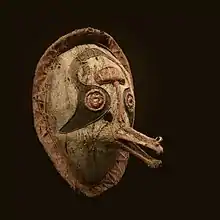Eharo mask
Eharo masks (literally "dance head" or "dance mask") were a type of mask used by the Elema people of the eastern Gulf of Papua as part of the "hevehe" cycle of masked rituals.[1] These masks were crafted from barkcloth, vegetable fiber, and various pigments.[2]

In contrast to the large sacred hevehe masks, the smaller eharo masks were meant for amusing the audience, and were used only twice during the 7 to 20 years long hevehe cycle (beginning and end).[2] The cycle is not practiced anymore today.[1] Some represented specific spirits, while others were simply humorous archetypes from stories. Because they are not as sacred compared to other masks, the women of the village were allowed to observe the mask's construction. These masks would later be burned about a month after the ceremonies, making it difficult to recover samples.[2]
It was during the time period of these practices that Vailala Madness took place. In an effort many rituals were destroyed and replaced with more European-accepted ones. Although this suppression took place, the Papuan Gulf people continued to practice these cycles and display their heritage.[3]
In modern-day these masks cycle through museums, along with photo galleries such as Hevebe: arts of the Papuan Gulf. This exhibition was where audience members were introduced to the vibrant and active nature of these masks to add a new dimension aside from the immobile items seen in collections.[4]
See also
References
| Wikimedia Commons has media related to Eharo masks of Papua New Guinea. |
- Metropolitan Museum of Art (New York, N.Y.); Kjellgren, Eric (2007). Oceania: Art of the Pacific Islands in the Metropolitan Museum of Art. Metropolitan Museum of Art. pp. 126–128. ISBN 978-1-58839-238-1.
- read, World Cultures 6 min. "Barkcloth dance masks from Papua New Guinea". National Museums Scotland. Retrieved 2019-08-07.
- Bell, Joshua A.; Geismar, Haidy (April 2009). "Materialising Oceania: New ethnographies of things in Melanesia and Polynesia". The Australian Journal of Anthropology. 20 (1): 3–27. doi:10.1111/j.1757-6547.2009.00001.x.
- Hill, Jude (July 2006). "Travelling objects: the Wellcome collection in Los Angeles, London and beyond". Cultural Geographies. 13 (3): 340–366. doi:10.1191/1474474006eu363oa.
